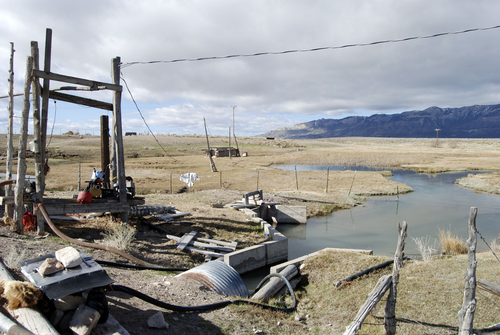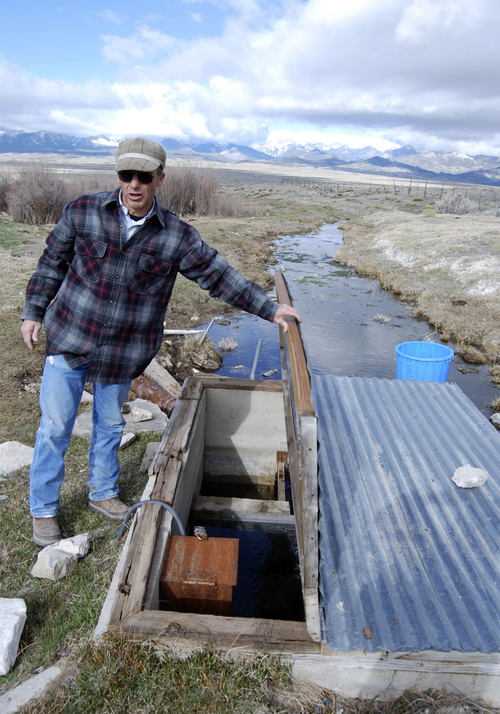This is an archived article that was published on sltrib.com in 2014, and information in the article may be outdated. It is provided only for personal research purposes and may not be reprinted.
For years, Snake Valley ranchers and environmentalists have complained Las Vegas' designs on rural groundwater would wreck their livelihoods and dry up fragile desert ecosystems in Utah's West Desert.
After years of groundwater monitoring and data analysis, new science is now confirming those fears — which are driven by the Southern Nevada Water Authority's (SNWA) proposal to tap Snake Valley aquifers. The U.S. Geological Survey last week published conclusions that the proposed withdrawals will depress groundwater levels and reduce discharge into the springs that support agriculture in this remote region straddling the Utah-Nevada line west of Delta.
The Utah Geological Survey, meanwhile, is preparing to publish findings that much of the groundwater in the area is ancient and its natural flow could be easily disrupted by further pumping.
"We are already seeing effects of current withdrawals depleting the springs. Future withdrawals will deplete springs as well," said USGS hydrologist Melissa Musbruch, a co-author of the study published in the journal Applied Geochemistry.
Her research team based its modeling on data the Utah Geological Survey is collecting as part of a comprehensive monitoring program and for a forthcoming study.
Such findings contradict Las Vegas water bosses, who have long held that valley can be tapped without harming its agriculture and ecology.
"While the Southern Nevada Water Authority has not yet completed a thorough review of the USGS report or model, we support additional efforts to further the existing knowledge and understanding of the groundwater basins in east-central Nevada," spokesman Bronson Mack said.
Wells currently pull 28,000 acre feet of water, which is mostly used to water cattle and alfalfa under existing water allotments. (An acre foot is 324,000 gallons, the volume covering an acre to a depth of one foot.)
Las Vegas has applied for water rights to 51,000 acre feet here, although it has pledged to take no more than 34,000 under an agreement with Utah. Gov. Gary Herbert, who last year rejected this deal.
SNWA proposes shipping groundwater from the Snake Valley and four rural Nevada valleys through a 285-mile pipeline expected to cost up to $15 billion. Critics fear that once infrastructure of this magnitude is built, it will be put to use regardless of the ecological and economic consequences.
The Nevada state engineer has awarded rights to the groundwater under the four Nevada valleys and the Bureau of Land Management has granted the right of way for the pipeline. Various groups, including two Utah counties and the LDS Church, are fighting these decisions in court.
Much of the water in play falls as winter snow in Nevada's Snake Range and other mountains towering to the west.
Groundwater feeds dozens of springs that make Snake Valley Utah's wettest desert, harboring habitat for least chub and spotted frog, two species of special concern, as well as 20 species of snail that live nowhere else.
Water runoff and inflow from valleys to the west recharge aquifers which slowly move water northwest toward the Great Salt Lake and Fish Springs Wildlife Refuge. Along the way, water surfaces at places such as Dearden Ranch, Needle Point and Stateline Springs, which Dean Baker, his sons and other Snake Valley ranch families rely on.
Needle Point went dry about a decade ago thanks to pumping, hydrologists said.
Through isotope analysis, the Utah survey team led by hydrologist Hugh Hurlow determined the water emerging at Stateline Springs fell as precipitation thousands, if not tens of thousands, of years ago and slowly migrated under the Snake Range from Spring Valley.
"There isn't a fast flow-through hydrological system," Hurlow said. "If you are taking water faster than it's being put back, that will depress groundwater levels. If you depress it more than 40 feet, the plants will die over time."
Under SNWA's plan, pumping here will more than double.
Hurlow suspects that under such groundwater withdrawals, discharge at vulnerable springs could taper by 75 to 100 percent.









